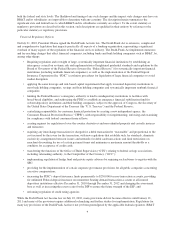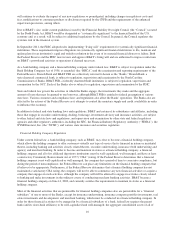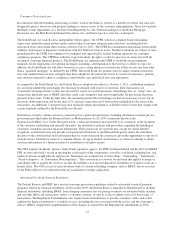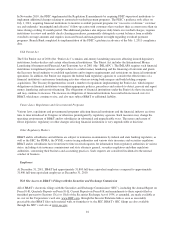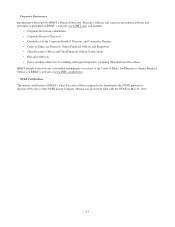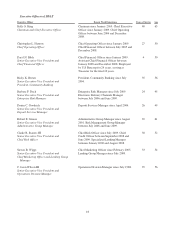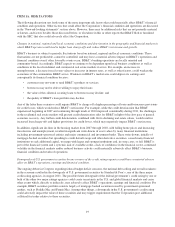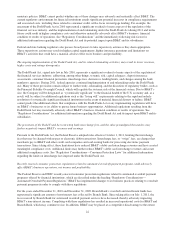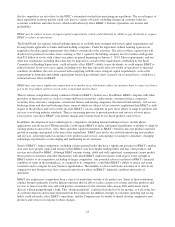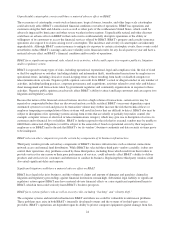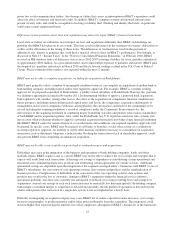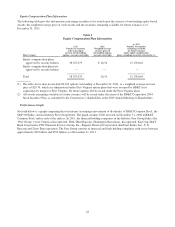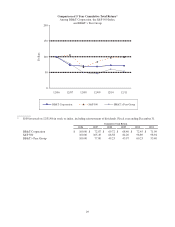BB&T 2011 Annual Report Download - page 19
Download and view the complete annual report
Please find page 19 of the 2011 BB&T annual report below. You can navigate through the pages in the report by either clicking on the pages listed below, or by using the keyword search tool below to find specific information within the annual report.ITEM 1A. RISK FACTORS
The following discussion sets forth some of the more important risk factors that could materially affect BB&T’s financial
condition and operations. Other factors that could affect the Corporation’s financial condition and operations are discussed
in the “Forward-looking statements” section above. However, there may be additional risks that are not presently material
or known, and factors besides those discussed below, or elsewhere in this or other reports that BB&T filed or furnished
with the SEC, that also could adversely affect the Corporation.
Changes in national, regional and local economic conditions and deterioration in the geographic and financial markets in
which BB&T operates could lead to higher loan charge-offs and reduce BB&T’s net income and growth.
BB&T’s business is subject to periodic fluctuations based on national, regional and local economic conditions. These
fluctuations are not predictable, cannot be controlled, and may have a material adverse impact on BB&T’s operations and
financial condition even if other favorable events occur. BB&T’s banking operations are locally oriented and
community-based. Accordingly, BB&T expects to continue to be dependent upon local business conditions as well as
conditions in the local residential and commercial real estate markets it serves. For example, an increase in
unemployment, a decrease in real estate values or increases in interest rates, as well as other factors, could weaken the
economies of the communities BB&T serves. Weakness in BB&T’s market area could depress its earnings and
consequently its financial condition because:
• customers may not want or need BB&T’s products or services;
• borrowers may not be able or willing to repay their loans;
• the value of the collateral securing loans to borrowers may decline; and
• the quality of BB&T’s loan portfolio may decline.
Any of the latter three scenarios could require BB&T to charge off a higher percentage of loans and/or increase provisions
for credit losses, which would reduce BB&T’s net income. For example, while the credit deterioration that BB&T
experienced beginning in 2007 and continuing through much of 2010 improved considerably during 2011, the challenges
in the residential real estate markets still present credit deterioration risks for BB&T in light of the slow pace of general
economic recovery. Any further credit deterioration, combined with flat to declining real estate values, would result in
increased loan charge-offs and higher provisions for credit losses, which may negatively impact BB&T’s net income.
In addition, significant declines in the housing market from 2007 through 2010, with falling home prices and increasing
foreclosures and unemployment, resulted in significant write-downs of asset values by many financial institutions,
including government-sponsored entities and major commercial and investment banks. These write-downs, initially of
mortgage-backed securities but spreading to credit default swaps and other derivative securities, caused many financial
institutions to seek additional capital, to merge with larger and stronger institutions and, in some cases, to fail. BB&T is
part of the financial system and a systemic lack of available credit, a lack of confidence in the financial sector, continued
volatility in the financial markets and/or reduced business activity could materially adversely affect BB&T’s business,
financial condition and results of operations.
Downgrades of U.S. government securities by one or more of the credit ratings agencies could have a material adverse
effect on BB&T’s operations, earnings and financial condition.
The ongoing debate in Congress regarding federal budget deficit concerns, the national debt ceiling and overall weakness
in the economy resulted in the downgrade of U.S. government securities by Standard & Poor’s, one of the three major
credit rating agencies, in August 2011. The possible future downgrade of the federal government’s credit rating by one or
both of the other two major ratings agencies could create uncertainty in the U.S. and global financial markets and cause
other events which, directly or indirectly, may adversely affect BB&T’s operations, earnings and financial condition. For
example, BB&T securities portfolio consists largely of mortgage backed securities issued by government sponsored
entities, such as Freddie Mac and Fannie Mae. Among other things, a downgrade in the U.S. government’s credit rating
could adversely impact the value of these securities and may trigger requirements that the Corporation post additional
collateral for trades relative to these securities.
19


